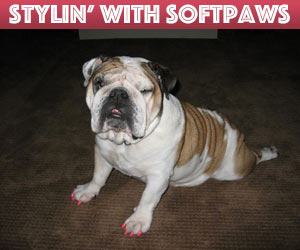Fall Allergies in Dogs: How to Spot the Signs and Help Your Pup Stay Comfortable

Can Dogs Really Get Seasonal Allergies?
Yes! Just like people, dogs can suffer from seasonal allergies, and fall is a prime time for symptoms to flare. As the air cools and leaves drop, allergens like mold spores, ragweed pollen, and dust from decaying leaves become more abundant.
Dogs exposed to these allergens may show a variety of signs — often mistaken for other health problems. Recognizing the patterns early helps you keep your pup comfortable.
While this article focuses on fall, many of the same signs and care tips apply to seasonal allergies year-round.
Common Symptoms of Fall Allergies in Dogs
Dogs don't usually present with “hay fever” symptoms like humans (watery eyes, sneezing). Instead, most signs are seen in their skin, ears, and paws, with some respiratory and digestive issues possible.
Skin & Coat
- Persistent itching (scratching at sides, belly, armpits, or groin)
- Red, inflamed, or irritated skin
- Hot spots (moist, painful patches from constant licking/chewing)
- Dry, flaky skin or dandruff
- Hair loss or thinning coat from over-grooming
- Secondary skin infections (often bacterial or yeast-related)
Ears
- Recurrent ear infections (redness, odor, discharge)
- Head shaking or tilting
- Excessive scratching at the ears
- Rubbing ears on the floor or furniture
- Thickened, darkened skin inside the ear (from chronic inflammation)
Paws
- Constant paw licking or chewing (sometimes until fur stains reddish-brown)
- Red, inflamed skin between toes
- Swollen paws or limping if severe
Respiratory Signs (Less Common)
- Sneezing
- Runny nose (usually clear)
- Coughing or wheezing (rare but possible if the airways are affected)
Digestive Signs (Less Common, But Possible)
- Soft stools or diarrhea
- Vomiting
- Gas or bloating
- Reduced appetite
Digestive signs are more strongly associated with food allergies, but some dogs experience overlap between food and seasonal triggers.
When It's Not Just Allergies
Here's the tricky part: allergy signs in dogs can mimic other problems, such as:
- Fleas or other parasites
- Food sensitivities or intolerances
- Skin infections not caused by allergies
- Environmental irritants (cleaning products, lawn chemicals)
A veterinary exam is the only way to sort out the true cause and prevent unnecessary discomfort.
How to Help Your Dog at Home
Even before medications are prescribed, you can make your dog more comfortable by reducing allergen exposure:
- Limit outdoor exposure on high-pollen days
- Wipe down paws and coat with a damp cloth after walks
- Bathe regularly with a gentle, hypoallergenic or medicated shampoo (ask your vet for recommendations)
- Vacuum and dust more frequently to reduce allergens indoors
-
Wash bedding weekly in hot water with a mild, fragrance-free detergent
- For dogs with sensitive skin, use an extra rinse cycle to ensure all soap is removed.
- You can also use a white vinegar rinse (about ½ cup in the rinse cycle) to naturally break down residues and allergens.
- Alternatively, skip additives and simply run an additional rinse cycle to remove detergent completely.
- Dry indoors using a dryer with high heat when allergens are high outside.
- On low-pollen days, sun-drying can help disinfect and freshen fabrics naturally — but avoid this option if your dog is highly sensitive to outdoor allergens.
- Use an air purifier to remove mold, pollen, and dust from the home environment.
Natural and Supportive Options
Some owners like to explore natural approaches alongside veterinary care. While these may not replace prescription treatments, they can support overall comfort:
-
Omega-3 fatty acids (fish oil or algae-based supplements): Can help reduce inflammation, support healthy skin/coat, and ease allergy-related itching.
- Dosage: The correct dose depends on your dog's weight, health status, and the concentration of EPA/DHA in the product. Always discuss the proper dosage with your veterinarian before starting.
-
 When to use caution: Omega-3s may not be recommended for dogs with:
When to use caution: Omega-3s may not be recommended for dogs with:- Pancreatitis (added fat can worsen the condition)
- Bleeding disorders or dogs on blood-thinners (Omega-3s can slightly reduce clotting ability)
- Certain gastrointestinal sensitivities (can cause diarrhea in some dogs if introduced too quickly or at high doses)
- Product choice: Always use pet-specific formulations or plain fish oil without flavorings. Avoid human omega-3 capsules that are flavored (many contain artificial sweeteners).
 Xylitol warning: Some human chewable or liquid omega-3 supplements contain xylitol, which is highly toxic to dogs. Double-check the label and never give these to pets.
Xylitol warning: Some human chewable or liquid omega-3 supplements contain xylitol, which is highly toxic to dogs. Double-check the label and never give these to pets.
-
Coconut oil (small amounts added to diet): May help skin barrier function in some dogs.
 Important Disclaimer: Coconut oil is very high in fat. Too much can contribute to weight gain, digestive upset, or even pancreatitis in sensitive dogs.
Important Disclaimer: Coconut oil is very high in fat. Too much can contribute to weight gain, digestive upset, or even pancreatitis in sensitive dogs.- It should never be used in dogs with a history or suspected history of pancreatitis.
-
Use with extreme caution (or avoid altogether) in dogs with:
- Obesity (extra calories and fat can worsen weight issues)
- Hyperlipidemia (high blood fat levels)
- Diabetes mellitus (extra fat may interfere with glucose control)
- Always introduce gradually, in very small amounts, and ask your veterinarian first before adding it to your dog's diet.
-
Quercetin (“nature's Benadryl”): A plant-derived antioxidant that may reduce histamine release.
-
 Contraindications: Quercetin may not be safe for dogs with:
Contraindications: Quercetin may not be safe for dogs with:- Kidney disease (metabolized/excreted partly via kidneys)
- Liver disease (processed by the liver, risk of strain)
- Bleeding disorders or dogs on blood thinners (mild anti-platelet effect)
- Dogs on certain medications (may interact with cyclosporine, corticosteroids, some antibiotics, or chemotherapy drugs)
- Pregnant or nursing dogs (safety not established)
- Side effects: High doses may cause GI upset (vomiting, diarrhea).
- Safety tip: Only use quercetin under veterinary guidance, and choose pet-formulated products (human supplements may contain unsafe fillers or sweeteners).
-
-
Herbal rinses (dog-specific): Oatmeal or chamomile rinses can soothe itchy skin externally.
- Always choose products formulated for dogs. Human shampoos, rinses, or DIY mixes may contain additives, fragrances, or concentrations that can sensitize or irritate a dog's skin.
- HEPA air filtration: Natural way to reduce indoor allergens without chemicals.
![]() Reminder: “Natural” doesn't always mean “safe.” Some herbs, essential oils, and supplements can be toxic to dogs. Always consult your veterinarian before starting any natural remedy.
Reminder: “Natural” doesn't always mean “safe.” Some herbs, essential oils, and supplements can be toxic to dogs. Always consult your veterinarian before starting any natural remedy.
Veterinary Treatment Options
If home care isn't enough, your veterinarian may recommend:
- Antihistamines: Sometimes helpful, though not effective for all dogs.
- Steroids (short-term use): Quickly reduce inflammation and itching but not ideal for long-term management.
- Prescription allergy medications: Such as Apoquel® or Cytopoint®, which target allergic itch more safely for chronic use.
- Medicated shampoos: To soothe irritated skin and remove allergens.
- Antibiotics or antifungals: If secondary bacterial or yeast infections develop.
- Allergy testing and immunotherapy: Allergy shots or oral drops can “retrain” the immune system for long-term relief.
 Important Safety Note
Important Safety Note
Never give your dog any over-the-counter human allergy or pain medications without veterinary approval. Many common human drugs — including ibuprofen, acetaminophen, and some antihistamines — can be toxic or even fatal to dogs. Always use medications prescribed or recommended by your veterinarian, in the correct dosage for your dog's size and health status.
The Bottom Line
Fall allergies can make life miserable for dogs, but with a watchful eye, proactive home care, and veterinary support, your pup can stay comfortable through the season. By addressing symptoms early and working with your veterinarian, you'll help your dog enjoy autumn walks and cozy nights without the itch and irritation.
Because when your dog feels better, you both can enjoy the season to the fullest.
You May Also Like These Articles:
Dogs and Allergies: Living with a Dog When You're Allergic
Atopy: Inhalant Allergies in Dogs
5 Fun Fall Recipes for Dogs: Treat Your Pup to Seasonal Goodies
October Hazards for Dogs: Keeping Your Canine Safe This Fall
Disclaimer: This website is not intended to replace professional consultation, diagnosis, or treatment by a licensed veterinarian. If you require any veterinary related advice, contact your veterinarian promptly. Information at DogHealth.com is exclusively of a general reference nature. Do not disregard veterinary advice or delay treatment as a result of accessing information at this site. Just Answer is an external service not affiliated with DogHealth.com.
Notice: Ask-a-Vet is an affiliated service for those who wish to speak with a veterinary professional about their pet's specific condition. Initially, a bot will ask questions to determine the general nature of your concern. Then, you will be transferred to a human. There is a charge for the service if you choose to connect to a veterinarian. Ask-a-Vet is not manned by the staff or owners of DogHealth.com, and the advice given should not delay or replace a visit to your veterinarian.



